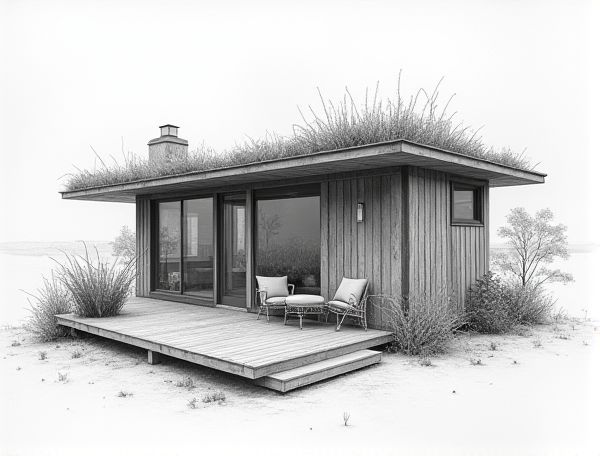
Photo illustration: Tiny home design with integrated vertical farming
Maximize Your living space by incorporating vertical farming into tiny home design, which enhances sustainability and provides fresh produce year-round. Discover innovative ideas and practical tips for creating a thriving tiny home garden by reading more in the article.
Introduction to Tiny Home Living
Tiny home living maximizes space efficiency by utilizing innovative design techniques that emphasize multifunctional furniture and open floor plans. Sustainable materials and energy-efficient appliances reduce environmental impact while maintaining comfort and functionality within compact square footage. This lifestyle promotes minimalism, financial freedom, and a simplified daily routine, appealing to eco-conscious individuals and those seeking affordable housing solutions.
Benefits of Integrated Vertical Farming
Integrated vertical farming maximizes your living space by transforming unused vertical areas into productive green zones, enhancing air quality and providing fresh, organic produce year-round. This sustainable approach reduces water usage by up to 90% compared to traditional farming, cutting your home's environmental footprint while boosting food security and aesthetic value.
Space-Efficient Layouts for Tiny Homes
Space-efficient layouts for tiny homes maximize functionality by incorporating multi-purpose furniture and vertical storage solutions, effectively utilizing every square inch. Open floor plans and strategically placed windows enhance natural light and create an illusion of spaciousness, improving comfort in compact living areas.
Choosing the Right Vertical Farming Systems
Selecting the right vertical farming system enhances space utilization and maximizes crop yield by integrating hydroponic, aeroponic, or aquaponic technologies tailored to your home's layout. Prioritize systems with adjustable LED lighting, automated nutrient delivery, and climate control features to optimize plant growth and energy efficiency in your vertical garden.
Top Crop Choices for Indoor Farming
Lettuce, spinach, and kale are top crop choices for indoor farming due to their fast growth cycles and high nutritional value. Herbs such as basil, mint, and cilantro thrive in controlled environments, providing fresh flavors year-round. Microgreens also offer a compact, space-efficient option with a quick harvest time, making them ideal for urban home designs with limited space.
Maximizing Natural Light and Ventilation
Maximizing natural light and ventilation in your home design enhances energy efficiency and indoor air quality, reducing reliance on artificial lighting and HVAC systems. Strategic placement of windows, skylights, and vents allows for optimal daylight penetration and cross-ventilation, creating a healthier, more comfortable living environment. Incorporating features like operable windows, light shelves, and open floor plans can significantly improve airflow and sunlight distribution throughout your space.
Sustainable Materials for Compact Construction
Sustainable materials such as bamboo, recycled steel, and reclaimed wood offer eco-friendly solutions for compact construction, enhancing energy efficiency and reducing environmental impact. Using low-VOC paints and natural insulation materials like sheep wool or cellulose helps maintain healthy indoor air quality while optimizing space. Your choice of these materials supports a greener home design, promoting durability and resource conservation in limited living areas.
Smart Water and Energy Solutions
Smart water and energy solutions integrate advanced sensors and automation to optimize your home's resource efficiency, reducing utility costs and environmental impact. Leveraging IoT technology, these systems provide real-time monitoring and adaptive controls to enhance sustainability and comfort in your living space.
DIY Tips for Installing Vertical Gardens
Maximize space and enhance aesthetics by selecting lightweight, moisture-resistant materials for vertical garden frames to ensure durability and ease of installation. Use modular planting pockets or containers with well-planned irrigation systems like drip lines to maintain consistent watering and promote healthy plant growth in vertical setups.
Real-Life Examples of Tiny Homes with Vertical Farms
Tiny homes with vertical farms maximize limited space by integrating multi-tiered plant growing systems within compact living areas, enhancing sustainability and self-sufficiency. Real-life examples include micro-houses in urban settings where vertical hydroponic setups provide fresh vegetables year-round, reducing grocery costs and carbon footprints. Your home can benefit from these designs by improving air quality and food security without sacrificing comfort or style.
 homedesy.com
homedesy.com